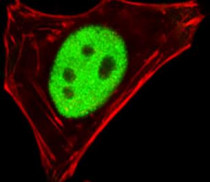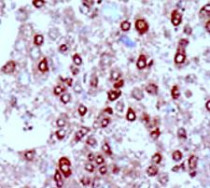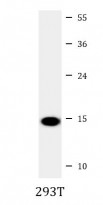ARG54893
anti-SUMO2 + SUMO3 antibody
anti-SUMO2 + SUMO3 antibody for ICC/IF,IHC-Formalin-fixed paraffin-embedded sections,Western blot and Human,Mouse
Cell Biology and Cellular Response antibody
Overview
| Product Description | Rabbit Polyclonal antibody recognizes SUMO2 + SUMO3 |
|---|---|
| Tested Reactivity | Hu, Ms |
| Predict Reactivity | Bov, Rat, Chk, Hm, Mk, Pig, Xenopus, Zfsh |
| Tested Application | ICC/IF, IHC-P, WB |
| Host | Rabbit |
| Clonality | Polyclonal |
| Isotype | IgG |
| Target Name | SUMO2 + SUMO3 |
| Antigen Species | Human |
| Immunogen | KLH-conjugated synthetic peptide corresponding to aa. 49-81 (C-terminus) of Human SUMO2 / SUMO3. |
| Conjugation | Un-conjugated |
| Alternate Names | SMT3 homolog 1; SMT3A; SUMO-3; SUMO-2; Small ubiquitin-related modifier 3; SMT3H1; Ubiquitin-like protein SMT3A; Smt3B; Smt3A |
Application Instructions
| Application Suggestion |
|
||||||||
|---|---|---|---|---|---|---|---|---|---|
| Application Note | * The dilutions indicate recommended starting dilutions and the optimal dilutions or concentrations should be determined by the scientist. | ||||||||
| Positive Control | 293T |
Properties
| Form | Liquid |
|---|---|
| Purification | Purification with Protein G. |
| Buffer | PBS and 0.09% (W/V) Sodium azide |
| Preservative | 0.09% (W/V) Sodium azide |
| Storage Instruction | For continuous use, store undiluted antibody at 2-8°C for up to a week. For long-term storage, aliquot and store at -20°C or below. Storage in frost free freezers is not recommended. Avoid repeated freeze/thaw cycles. Suggest spin the vial prior to opening. The antibody solution should be gently mixed before use. |
| Note | For laboratory research only, not for drug, diagnostic or other use. |
Bioinformation
| Database Links |
Swiss-port # P55854 Human Small ubiquitin-related modifier 3 Swiss-port # Q9Z172 Mouse Small ubiquitin-related modifier 3 |
|---|---|
| Gene Symbol | SUMO3 |
| Gene Full Name | small ubiquitin-like modifier 3 |
| Background | This gene encodes a member of the small ubiquitin-related modifier (SUMO) family of eukaryotic proteins. The encoded protein is covalently conjugated to other proteins via a post-translation modification known as sumoylation. Sumoylation may play a role in a wide variety of cellular processes, including nuclear transport, DNA replication and repair, mitosis, transcriptional regulation, and signal transduction. Alternatively spliced transcript variants encoding distinct proteins have been described. [provided by RefSeq, Feb 2014] |
| Function | Ubiquitin-like protein which can be covalently attached to target lysines either as a monomer or as a lysine-linked polymer. Does not seem to be involved in protein degradation and may function as an antagonist of ubiquitin in the degradation process. Plays a role in a number of cellular processes such as nuclear transport, DNA replication and repair, mitosis and signal transduction. Covalent attachment to its substrates requires prior activation by the E1 complex SAE1-SAE2 and linkage to the E2 enzyme UBE2I, and can be promoted by an E3 ligase such as PIAS1-4, RANBP2 or CBX4 (PubMed:11451954, PubMed:18538659, PubMed:21965678). Plays a role in the regulation of sumoylation status of SETX (PubMed:24105744). [UniProt] |
| Cellular Localization | Cytoplasm. Nucleus. Nucleus, PML body |
| Research Area | Cell Biology and Cellular Response antibody |
| Calculated MW | 12 kDa |
| PTM | Polymeric chains can be formed through Lys-11 cross-linking. Cleavage of precursor form by SENP1, SENP2 or SENP5 is necessary for function. |
Images (3) Click the Picture to Zoom In
-
ARG54893 anti-SUMO2 + SUMO3 antibody ICC/IF image
Immunofluorescence: HeLa cells stained with ARG54893 anti-SUMO2 + SUMO3 antibody (green) at 1:100 dilution. Cytoplasmic actin was counterstained with Alexa Fluor® 555 conjugated with Phalloidin (red).
-
ARG54893 anti-SUMO2 + SUMO3 antibody IHC-P image
Immunohistochemistry: Formalin-fixed and paraffin-embedded Human hepatocarcinoma tissue stained with ARG54893 anti-SUMO2 + SUMO3 antibody.
-
ARG54893 anti-SUMO2 + SUMO3 antibody WB image
Western blot: 35 µg of 293T cell lysate stained with ARG54893 anti-SUMO2 + SUMO3 antibody at 1:1000 dilution.








